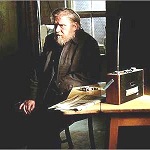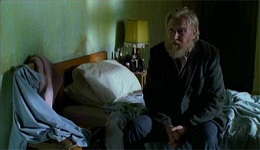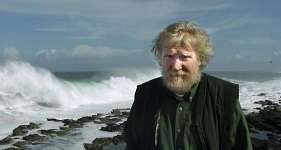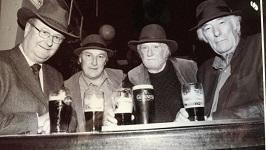Life
| 1947-2014; b. 9 Nov. 1947, Finnea, Co. Westmeath, son of a Garda; grew up in Co. Cavan; worked at various jobs in London from his teens, living in Pimlico; returned to Ireland and settled in a cottage at Balyconnell, Co. Sligo; fnd. and ed. Drumlin [lit. mag.], 1979-80; winner of Hennessy Award, 1974 and 1976; director, Hacklers Drama Group, 1980-81; issued Banished Misfortune (1982); winner of Tom Gallon Award, 1983; issued Fighting with Shadows (1984), a novel set on Fermanagh border; issued A Goat’s Song (1994), a novel set in Donegal and dealing with a love affair between a Catholic man and a Protestant woman - a first an MS of 740pp., cut to avoid lawsuits and severally reduced by his editor Bill Swainson; wrote Our Boys (1980) and The Next Bed (?1987), film scripts; issued The Ballyconnell Colours (1992), a poetry collection; |
| contrib light-hearted article to Culture in Ireland (1993), ed. by Prionsias Ó Driosceoil), though barbed in respect of the ‘closed mind’ of new liberals; issued The Bend for Home (1996), an atmospheric memoir of childhood with his family including a colourful aunt, Maisie, turned cynical by lost love - rated among best Irish memoirs ever; elected a member of Aosdana; author-performer, with Fintan Vallely, of The Humours of Ballyconnell; issued poems, What the Hammer (1998); played the lead in Nichola Bruce’s film of Irish emigrant life in London, I Could Read the Sky (1999), dir. Bruce, from the book by Timothy O’Grady - a tale of West of Ireland childhood and life in London as emigrant worker, recounted by an old man; |
| issued short story After the Off (1999), a story of racing-life in rural Ireland, accompanying pictures by Bruce Gilden; appeared in Mr. Staines (1999), dir. by Gavin Quinn, with Fidelma Cullen and others; dir. Beckett’s Footfalls at the Gate Beckett Festival; ed. Force 10; issued The Reed Bed (2001) poetry collection; Healy was the subject of Art Lives: The Writing in the Sky, narrated by Seán McGinley (RTE 1, Tuesday 12 Jan., 2011); issued A Fool’s Errand (2010), based on migration of Greenland geese; an extract from a new novel, Long Time No See, appeared in The Stinging Fly (Spring 2011); issued Long Time, No See (2011), the story of Philip (known as Mr Psyche), living in an Irish town with dark secrets; m. to Helen, with a son, Dallan; d. 29 June, 2014; bur. Carrigans Cemetery. DIW DIL OCIL FDA |
[ Note: On his return to Ireland, Healy received much encouragement amounting to mentorship from Aidan Higgins - also settled in Sligo, and later in Kinsale. ]
 |
 |
 |
 |
|||
| ||||||
[ top ]
Works| Short fiction | ||
|
||
| Novels | ||
|
||
| Autobiography | ||
|
||
| Poetry | ||
|
||
| Drama | ||
|
||
See also Men to the Right, Women to the Left [in collaboration with the Clones Drama Group], in Stories of the Drumlins: A Collaborative Theatre Project Developed by the Abbey Theatre, Positive Age and the Health Service Executive (North East) / (Dublin: Outreach/Education Dept. of Abbey Theatre 2005), 115pp. |
||
| Collected Works | ||
|
||
| Film Scripts | ||
|
||
| Miscellaneous | ||
|
||
Further: |
||
|
Bibliographical details
My Generation: Rock 'n' Roll Remembered: An Imperfect History, ed. Antony Farrell, Vivienne Guinness & Julian Lloyd; [asst. eds., Brendan Barrington & Faith O’Grady] (Dublin: Lilliput Press 1996), xii, 339pp. [see details]. incls Dermot Healy. with Tim Booth; Paul Brady; Philip Casey; Lar Cassidy; Paul Charles; Denny Cordell; Mary Coughlan; Jeananne Crowley; Peter Cunningham; P.J. Curtis; Barry Devlin; Keith Donald; Donovan; Theo Dorgan; Roddy Doyle; John Dunne; Anne Enright; Marianne Faithfull; BP Fallon; Peter Fallon; Alec Finn; Aisling Foster; John Wilson Foster; Martin Gale; Carlo Gebler; Kathy Gilfillan; Elgy Gillespie; Tim Goulding; Bill Graham; Hugo Hamilton; Mick Hanly; Dermot Healy; Desmond Hogan; John Hutchinson; Mary Kenny; Michael Lindsay-Hogg; Shane MacGowan; Pat McCabe; Nell McCafferty; Ciaran McGinley; Patrick McGrath; Frank McGuinness; Paul McGuinness; Paddy Moloney; Danny Morrison; Terry Moylan; Paul Muldoon; Kevin Myers; Charles Naper; George O’Brien; Joe O’Connor; Tim O’Grady; Fintan O’Toole; Rhonda Paisley; Noel Redding; Martin Rowson; Jim & Peter Sheridan; Pete Short; James Simmons; John Stephenson; Colm Toibin; Niall Toner; Brian Trench; Paolo Tullio; Mark Venner; Dick Warner; Ian Whitcomb; Kathleen Williamson; Ron Wood; Terry Woods].
[ top ]
Criticism
|
|
[ top ]
| Healy has been called Patrick Kavanagh’s successor by Seamus Heaney and Ireland’s greatest writer by Roddy Doyle. (See Kevin Courtney, TV Review [column], in The Irish Times, 8 Jan. 2011, Weekend Review, p.16.) |
Maurice Harmon, ‘First Impressions: 1968-78’, in The Irish Short Story, ed. Terence Brown & Patrick Rafroidi (Gerrards Cross: Colin Smythe 1979): ‘Dermot Healy’s is intensely sensitive to the real world. This world, Healy says in “Jude and his Mother”, is “contained with the maximum of pleasure on the shiny surface of a penny piece”. Any reality, he declares, is only appraised by its followers. In “The Island and the Calves” he concentrates on the phenomena of the visible and the audible, writing of one of its characters - “at last he had authenticated the outside world, and each part was now sustained by itself and no longer needed a deity nor an interpreter”. The gravity of the relationships between perceiver and object recurs in these writers. Here the whole story affirms an appreciation of the ordinary in the intensity of its imagined details, and in its counterpointing of the natural setting against the ritual of the Mass. Nature is the song of songs.’ (p.73.)
Gerald Dawe, review of A Goat’s Song, in Fortnight Review (July-Aug. 1994), ‘Summer Books’: The novel concerns the break-up between a southern writer and his northern born and bred girlfriend, replaying in widening circles of time and location, the religious and cultural diversity of the country; includes portrait of the inner life of a devoted Protestant and RUC-man, Jonathan Adams [father of the girlfriend]. (p.27.)
Danny Morrison, review of The Bend in the Road, in Fortnight (Nov. 1996), [q.p.], with remarks on an occasion when Healy challenged an IRA O/C to snooker and further personal reminiscences; highly appreciative review.
John Dunne, review of The Bend for Home (1996), in Books Ireland (Nov. 1996), finding it less brilliant than The Goat’s Song, with criticisms of the mid-section based on a teenage diary in particular, but guarantees laughter at the geriatric antics of three sisters; quotes, ‘I mind to see a man hanging from a tree. Maybe I didn’t see a man but heard it from my mother. Whatever she saw I say it again through her eyes as I do now, writing this down’, and remarks that the hanging man appeared in Goat Song. (p.321.)
[q.a.], review of After the Off, in Books Ireland (March 2000), comments upon ‘Healy’s brilliantly heard and echoed story-cum-dialogue-poetry.’ (p.81.)
[ top ]
Colin Graham, ‘Words on the wing’, review of A Fool’s Errand, in The Irish Times (20 Nov. 2010): ‘Dermot Healy’s poetry has an intensity to its sparseness. In A Fool’s Errand [...] Healy’s voice is as concentrated and confident as it was in that 2001 [The Reed Bed] collection. A Fool’s Errand is a series of poems contemplating loss and the passage of time through the migration and return of barnacle geese. While the migratory patterns of geese are a relatively well-worn theme in recent nature writing, Healy finds formal and thematic ways to make the subject his own. Each poem is a sonnet, weighted in the middle with two sections of three lines each, longer than the lines that begin and end the sonnet. The visual effect is to imitate the V of geese in flight. The small and quiet beginnings, then expansion, and then contraction to a conclusion allow Healy a variety of ways in which to think about the noise, behaviour and constancy of the geese as tangentially reflective of human life. Early poems in the book move between the geese and the death of a musician friend. The enigmatic to and fro of the geese’s yearly patterns make them an “orchestra of memory”, something close to being reassuringly repetitive, as the funeral of the musician comes to a close in a “long silence”. Elsewhere in the book the geese are waited for, their “wild symmetry” in flight is wondered at, and the circularity of their lives hints at consolation.What Healy describes, in the final phrase of A Fool’s Errand, as an “ebbing song” is this book, one that is alive to the sounds and mysteries of natural phenomena. And Healy is wise enough never to think that his metaphors or his poetry can turn the flow of the natural world into anything other than “unsure knowledge”’.
Eileen Battersby, ‘From Chatty Comments to Chilling Observations’, review of Long Time, No See, in The Irish Times (26 March 2011), Weekend Review, p.10 [with b&w photo-port. by Dallan Healy]: ‘[...] Dermot Healy’s new novel, his first since the gritty Sudden Times (2000), is difficult; it is slow moving and complacent, and at times dangerously relaxed, lacking the urgency of his life’s achievement to date, A Goat’s Song (1994). [...] There is no doubting that Healy is a writer’s writer, and writers will appreciate the difficulty in establishing the continuity that runs through the extravagant narrative. But for a reader it is hard going. [...] In The Bend for Home (1996), his atmospheric memoir, Healy triumphed in the role of all-seeing observer. [...] Although Long Time, No See is a novel of voices, one-liners and chatty comments, the most chilling observations are invariably made by Joejoe, not the narrator. Joejoe, who trained a robin to walk on the toe of his boot, concedes that it was he who fired the gun in an attempt “to kill my ghost”. This big, wayward narrative strains and heaves and pushes, and it pitches many thematic questions, most of which Healy has answered in his narrative poem A Fool’s Errand (2010), such as why do the geese respond to a clock they don’t have? Why do the living fear the dead? And why do the dead retain such power over the living? / Healy, an experienced writer, has attempted to write a young man’s book. It doesn’t quite work. His narrator is too wise, the story too obvious.’ [End.] (See full-text copy in RICORSO Library, “Criticism > Reviews”, via index, or direct; see also Eugene McCabe’s response to the review and some ensuing interventions by others, under McCabe, infra.)
Sean O’Hagan, ‘[...; quotes] ‘I try to stay out of it and let the reader take over’, interview with Dermot Healy, in The Observer, (3 April 2011): The book is, he says, “a bit of a curved mystery”. Or, to be more precise, it is an episodic, slowly unfolding narrative in which there are many curves and many mysteries, most of which are left unresolved: like life, in fact. The tale is told by a character known as Mister Psyche, a teenager touched by trauma and trapped for the novel’s duration in that hinterland between grieving and moving on. He doggedly builds a dry stone wall, helps his father on odd jobs, and looks after two anarchic pensioners, the Blackbird and Uncle Joe-Joe, fetching them their weekly supply of Malibu and cigarettes from the local supermarket. The narrative takes a sudden swerve when a bullet hole appears in Uncle Joe-Joe’s front window, though how or why it got to be there is never quite explained. Long Time, No See is not a book that provides answers, and even the questions it asks are elliptical. Time passes, people get on with everyday life, get drunk, get ill, fall out, make up and persevere. The seasons change but the wind from the ocean is a constant, likewise the mysterious undercurrents of life in this parochial, but universal, community.’ (See full-text copy in RICORSO Library, “Criticism > Reviews”, via index, or direct.)
| Shaun Richards, review of Collected Plays of Dermot Healy, in Etudes Irlandaises [421:7] (2017), pp.196-98: |
|
| Available at Études Irlandaises - online; accessed 14.08.2021. |
[ top ]
References
Peter Fallon & Seán Golden, eds., Soft Day: A Miscellany of Contemporary Irish Writing (Dublin: Wolfhound; Notre Dame 1980), selects “A Family and a Future”.
[ top ]
Notes
Goat’s Song (1994): Ferris, a fisher and a playwright, awaits the return of his lover Catherine but by the time he receives her letters, the affair is over. Battling against drink, he tries to recreate her on paper narrating the stories of her father, an RUC sergeant and failed Protestant preacher, her mother, a Methodist from the Free State, her sister Sara, and ultimately of himself. Healy tells with compassion and gentle humour how the older generation are drawn out from their narrow confines and into “enemy” territory by personal ties, and how the Sergeant’s ledger of Fenian supporters is used by the Special Branch, compelling him to move his family to the South of Ireland. By the time Catherine brings her Southern lover up to Belfast, life is more dangerous, and Ferris, left to himself, compulsively puts his head in the lion’s jaws. Winner of the Encore Award for a second novel. (See Kirkus UK; copied at COPAC online; accessed 26.02.2011.)
I Could Read the Sky (1999), dir. Nichola Bruce, based on the book by Timothy O’Grady and scripted by Steve Pyke, with Stephen Rea and Maria Doyle Kennedy, et al. - a tale of West of Ireland childhood and life in London as emigrant worker, recounted by an old man; with music by seán-nos singer Iarla Ó Lionáird (issued as a CD, 2000); incls. songs such as “Knuckles To The Marrow” with Irish rapper Rí-Rá; expresses both the hero’s loathing of England and his pride in wielding an anonymous shovel on public works.
Dermot Healy, Long Time, No See (Faber & Faber 2006), 438pp. Long Time, No See introduces us to the unforgettable world of Mister Psyche. In the isolated coastal townland of Ballintra in the Northwest of Ireland Recent school-leaver, occasional worker, full-time companion and Malibu-provider to Uncle Joe-Joe and his friend, The Blackbird, Psyche is a boy on the cusp of adulthood, undone by a recent traumatic event. Hanging out with men some forty-plus years his senior proves hazardous for Mister Psyche when the appearance of a bullet-hole in Uncle Joe-Joe’s window draws him into a series of (mis)-adventures which unsettle and bemuse. Perhaps The Blackbird is losing it? Or perhaps The General has decided to act on a decades-old grudge? Whichever way, as the paranoia grabs a creeping hold of Uncle Joe-Joe, his fragile world threatens to collapse. And it is Mister Psyche who must digest this and acknowledge the new world taking shape in the old ...An epic in miniature peopled by a cast of innocents and broken misfits, Long Time, No See’s lyrical power casts a miraculous literary spell.
—See Waterstone’s - online; accessed 27.02.2011.
Fighting with Shadows (rep. edn. 2016): Eugene O’Brien writes: ‘The novel is a challenging text, dealing with the border in Ireland; at a metaphorical level it also deals with borders across all aspects of our lives. A village straddles the border, and the only bridge across the river Erne is in danger of being destroyed. The novel focuses on the Allen family: one brother (George) lives in Northern Ireland; another brother (Tom) is in the Republic; a third brother (Frank) has emigrated. Healy’s eye for detail is important and the text involves a significant braiding of plot, character, and a seemingly incidental focus on descriptive information. Healy’s is a view that sees ‘the erotica of little things”.’ (Review, Irish University Review, Nov. 2017.)
[ top ]